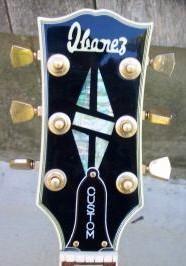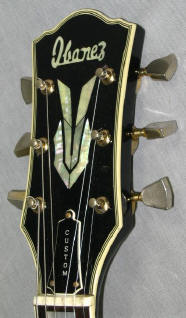|
Lawsuit! Lawsuit! Anyone who cruises eBay
looking for old Ibanez guitars quickly finds the word “lawsuit”. Like many
words in our society, this one is oft used, seldom understood. Find an old Ibanez
that is a copy of another, more familiar guitar? Clearly a “lawsuit”! I
have seen guitars go for much more than they are actually worth simply because the
purchaser has fallen for the hype or actually didn't know what constitutes a
"lawsuit" model. Here is my attempt to clear up an urban legend, and, in
the words of Chuck D., “Don’t believe the hype.”
In 1954, Harry Rosenbloom opened a music store called Medley Music in Bryn Mawr,
Pennsylvania, just northwest of Philadelphia. The country was in the post-World
War II music
boom, and guitars were very popular. As the store grew Mr. Rosenbloom was having trouble
getting product. For example, the waiting list for new Martin guitars was
reportedly over three years..
Mr. Rosenbloom decided to start a guitar manufacturing business to solve his inventory
problem. The Martin guitar factory was located about 70 miles from his store in Nazareth,
PA, and his goal was to exceed their quality. He formed a new company called Elger
Guitars, named for his children Ellen and Gerson. He made the first few instruments
himself in 1959, but quickly realized the challenges of producing sufficient quantities of
guitars. He brought in a German master violin maker named Karl Muller. Karl and his
brother, Georg, led a small team of craftsman who designed and built the Elger Guitars in
a workshop in nearby Ardmore, Pennsylvania. They continued to hand-build exceptional
quality instruments until about 1964.
In 1964/65 Mr. Rosenbloom decided to stop production of the hand-made instruments and
begin importing guitars instead. In a stroke of remarkable insight -- and 90’s
style outsourcing -- Elger Guitars chose to become the exclusive North American
distributors for the Hoshino Gakki Gen Company, a Japanese instrument manufacturer.
Remember that back in the 60’s Made in Japan still had a negative
connotation. In my opinion, Mr. Rosenbloom understood this, and chose a decidedly
non-Japanese name for the guitars. Hoshino had just bought a small Spanish guitar company
named Ibanez and would use this as their product name. Interestingly, the
last Elgers (1965 to about 1970) are all Japanese-made (and indicate that on their labels)
and are actually quite close in design to what was to become the Ibanez line of the
1970's.
In 1971, Hoshino bought Elger Guitars, regaining the North American distribution rights,
and changed the name to "Ibanez USA". Hoshino did maintain Elger's
Pennsylvania facilities to check incoming shipments and correct any flaws prior to
shipping merchandise out to their dealers. It is also my understanding that the
serial numbers were actually placed on the guitars in the USA when that practice
started.
Having started as a relatively unknown and low-budget Japanese guitar brand, Ibanez
discovered the way to success around 1970 when they started making copies of well-known
American guitars like Gibson, Fender and Rickenbacker. They did a good job: the guitars
were good copies, at least from a visual point of view. Non-Free Traders take note:
they were able to make these guitars affordable due to cheaper materials and labor,
coupled with a higher level of automation when compared to their American counterparts.
Mr. Rosenbloom figured it out early: make a guitar that “looks” great and
similar to a “big name” guitar and people will buy it. This is precisely the
phenomenon we see with today’s Epiphones.
Before we get too sentimental we must remember that when you inspect some of the earlier
guitars that the construction was not completely accurate and faithful to the originals.
Most of the Les Paul copies had bolt-on necks and multi-piece, plywood tops. Routings for
electronics and wiring were pretty rough in a manner similar to today’s Indonesian
guitars. But Ibanez got very popular because young guitarists that could not afford a
Gibson or a Fender could buy a guitar that offered a good balance between price and
quality...and looked professional!
On June 28, 1977, Norlin, the parent company of Gibson, filed a
lawsuit against Elger (Ibanez) in Philadelphia Federal District Court .
The case was "Gibson Vs. Elger Co." with Gibson claiming trademark infringement
based on the duplicate "open book" or "moustache" headstock design of the Ibanez
copies. Allegedly Gibson had threatened to
sue Elger/Ibanez for a long time regarding the use of the headstock
which Norlin claimed as a Gibson trademark. Ironically, by the fall of 1976 Ibanez
had redesigned their headstocks to look much like those found Guild guitars. The new
headstock design even appeared in the 1976 catalog! So, conspiracy
theorists, by the time the lawsuit was
actually filed, the headstocks had already been changed. While "lawsuit" head
generally means a Gibson copy headstock, the Ibanez headstock at the time of the lawsuit
was
actually a copy of a Guild headstock. It is an urban legend that the Gibson/Norlin lawsuit
was filed against a number of Japanese companies. It is also commonly held it was over the
exact copying of American designs. Neither of these urban legends are true.
|

